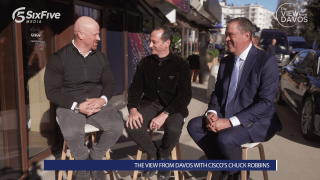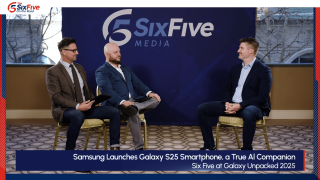The Six Five team discusses Arm & Qualcomm Lawsuit In The Jury’s Hands
If you are interested in watching the full episode you can check it out here.
Disclaimer: The Six Five Webcast is for information and entertainment purposes only. Over the course of this webcast, we may talk about companies that are publicly traded and we may even reference that fact and their equity share price, but please do not take anything that we say as a recommendation about what you should do with your investment dollars. We are not investment advisors and we ask that you do not treat us as such.
Transcript:
Daniel Newman: In the great northeast, a court case began this week. It was Arm and Qualcomm. A lot of attention on this one, Pat. What is going on with the Arm-Qualcomm lawsuit?
Patrick Moorhead: Yeah, so you have Arm, an absolute intellectual property powerhouse. Stock is just absolutely flying since they got back on the market. You have Qualcomm, also an intellectual property powerhouse, but they also are a designer and seller of multiple chips out there. And this comes down to the Nuvia acquisition and the intellectual property around that and the price that both companies believe that they deserve to either buy it for or charge. And it comes down to you’re going to have terms called an ALA, which is an architectural license agreement, and then you have a TLA, which is a technology license agreement. And what I’m going to do is try to give both sides of the argument here. So Arm is essentially saying that Qualcomm violated Nuvia’s ALA and are integrating Nuvia’s technology into its chips without getting Arm’s approval. And it wanted Qualcomm to destroy all products that have that. Arm is also saying that, essentially this is a fact, the Nuvia ALA was at a higher royalty rate compared to Qualcomm’s current architecture license agreement and is improperly applying it to its Nuvia designs. And essentially, and this is one that is getting a lot of contention out there, Arm is saying that essentially, as ownership of the derivative designs that come off of an ALA, and that’s getting a lot of people kind of talking about that.
And it’s all about money. And Qualcomm is coming in saying, “Hey, we’re using the ALA that we have,” which is lower price, which I think goes out there until 2028, extends to Nuvia post acquisition and therefore it didn’t need a new license from Arm. And it’s also saying that, “Hey, these are custom cores that we did, which is distinct from Arm intellectual property. It’s our intellectual property,” and is saying that, “Hey, micro architecture is different from architecture of the cores itself.” And instruction sets are essentially the language that software speak. You got X86, you’ve got RISC, you’ve got MIPS, and you have Arm. And Qualcomm is saying that Arm is essentially using it to shake it down under a TLA structure, which is a lot more expensive than an ALA. So TLA is about 5%, ALA is about 1%. So, yeah, it’s in the jury right now. Gosh, what a short-
Daniel Newman: So short.
Patrick Moorhead: It was like a week-
Daniel Newman: Three days or something.
Patrick Moorhead: So question, did Qualcomm and Nuvia breach the Nuvia ALA? Are Qualcomm’s products licensed under its existing ALA with Arm or did they need a separate agreement under the TLA? By the way, both companies believe that they have each other exactly where they want. I’ve never seen… Well, no, I guess everybody digs in if they’re going to go to trial. I had expected a settlement here, but we should, in the next two weeks if not today, have a settlement.
Daniel Newman: So what’s your prognostication? I mean-
Patrick Moorhead: Dan, I take the shot every single time. This one is so, so hard for me. I think the biggest thing I think through, if I’m understanding this correctly, is the fact that Arm would actually own a derivative product that somebody had an architectural license for. Essentially, if this is the same type of contract it has with Apple, Arm actually owns the bionic cores. Or maybe I’m just confusing it in that that’s actually Arm says it’s TLA and it owns it. So, I just don’t know, Dan. I just don’t know. I’m not even going to take the shot on this one.
Daniel Newman: Yeah, it’s really hard to say. I’ve struggled. First of all, anybody that’s been through any meaningful litigation or legal process knows that it can be super unpredictable. There’s a reason that Apple settled on the doorstep heading into the last day with the Qualcomm deal. It wasn’t just because they were some level of certainty they were going to lose, whatever that outcome could be, there’s a greater amount of predictability in terms of settling and moving forward. Especially they need to work together. And I mean that’s one of the cases here, is there any circumstance in which these two companies don’t need each other? I mean it’s not like if the deal goes south that Qualcomm can just run and do this with someone else. I mean could they make a pivot to RISC-V in the future? I mean sure, but that’s a multi, multi-year process, and it can’t. And is there a situation in which Arm is bettering its shareholders or its business by not having a great relationship with Qualcomm? I don’t see that either.
So, maybe less about what each party wants. And both of us have had the chance to talk to both parties and both feel they have a great case. Both feel that they… And of course, I don’t know, I’ve never gone into a situation where two major companies are litigating something like this and they both don’t feel like they’re in the right. I have never had it happen. I’m not saying it hasn’t, but in the end, I think we know Arm’s direction is about being able to increase its royalties and especially expand when it’s adding more value. That’s a big part of what it’s trying to do. It basically is looking at the fact that this was a company, Nuvia was making server chips, or that was the idea of it. And now a lot of that technology ended up being used in PC technology that Qualcomm is doing and I think they want more proverbial dollars per device. I mean that’s what would be the outcome for them. I mean Qualcomm basically is saying, “Look, we’ve been developing under Arm forever. What’s to say what was being developed is part of the one agreement versus what was being developed under the other agreement?” And I mean that’s all speculative as well I think. And then the question is whether they used 1% or 90% of the IP, is there any level of which using any of it is acceptable? I mean I think you and I are both mature enough and grown up enough to say we’re not lawyers, but what I would say is the unpredictability of this whole thing is really substantial. I think it’ll settle. I just do. I think in the end, both parties are going to-
Patrick Moorhead: This is at the jury. So you think that they’re going to settle before the jury comes back maybe today?
Daniel Newman: I think there’s a possibility. This is a bit of a bold call, but it’s the predictability thing. I mean maybe not, maybe not. I mean if the jury does come back with something, because like I said, if one side gets a very strong ruling, why would they want to come to any compromise?
Patrick Moorhead: Well that’s why I’m asking. Literally it’s with the jury right now.
Daniel Newman: Yeah, I mean isn’t that kind of what happened with the Apple case?
Patrick Moorhead: One day. First day of testimony, Apple pulled the plug and realized that Qualcomm literally had the smoking gun. And I think they also realized that there was no way that Intel was going to come in and support them for 5G and we better become friends with Qualcomm now.
Daniel Newman: God, I don’t know, man. I’m going to take off my Esquire hat and I’m going to kind of go with you about calling the shot. I just have to imagine there’s some intense conversations going on. I just do. So much risk in just letting the cards go. I mean alternatively, you let it fall and then there’s a multi-step appeal process and that’ll take a whole bunch of time too, but it’s just-
Patrick Moorhead: Good point. Good point.
Daniel Newman: These companies need each other. That’s why I really don’t understand why they can’t… I do understand they’re both trying to accomplish, I just don’t know in the end that they’re both not creating a lot of risk for shareholders, but that’s what happens, Pat. You and I know. When you really feel you got the right side of the case, sometimes the desire to see it through is bigger than the desire to try to find a common ground. So, we’ll keep an eye on this one. It’s always fun to play the part, but we’ll see how quick it comes back. And by the way, if it comes back super quickly, that’s usually never a good thing for one party either.






















































































